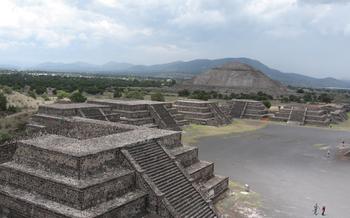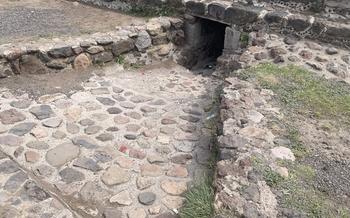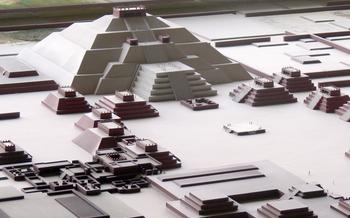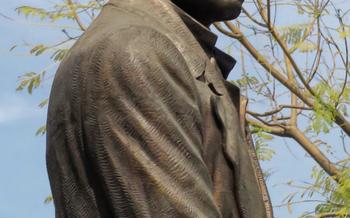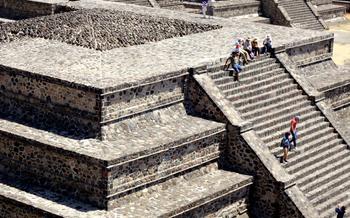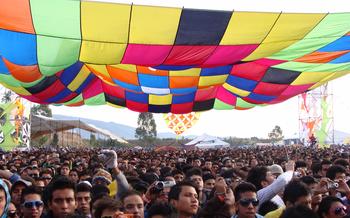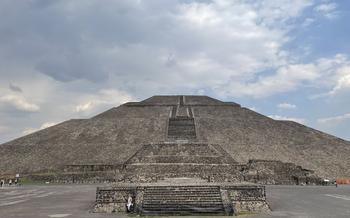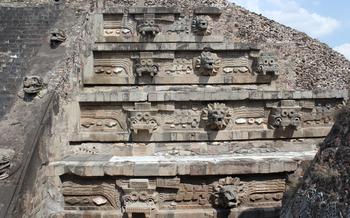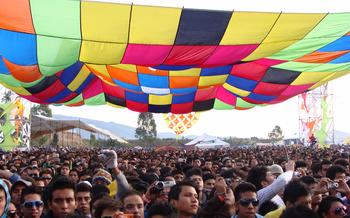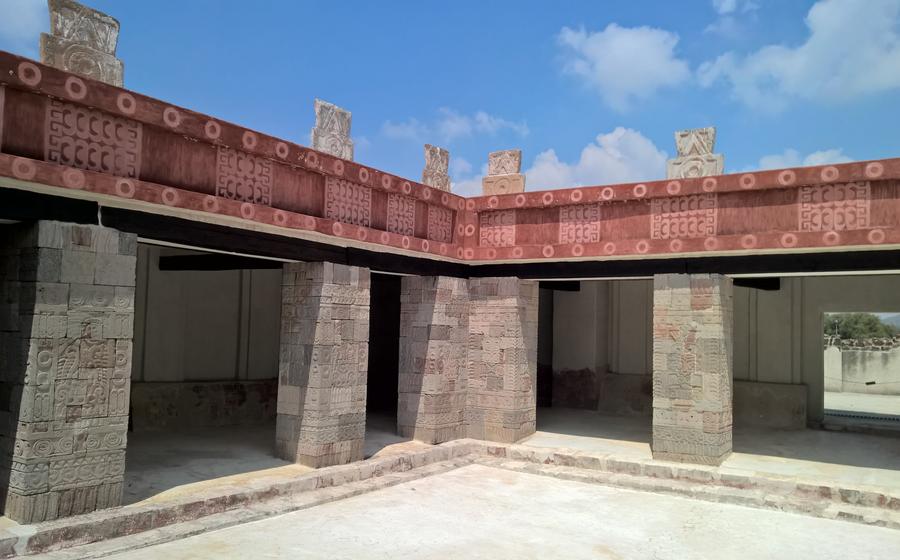
Palacio de Quetzalpapalotl
- A Journey to Quetzalcoatl's Palace
- Exploring the Palace's Layout
- Stepping into the Royal Chambers
- Decoding the Murals and Symbols
- Courtyards and Gardens: A Place for Rituals
- The Palace's Connection to the City:
- The Palace's Legacy: A Window into the Past
- Unforgettable Encounters
- Beyond the Palacio: Exploring Teotihuacan
- Tips for Photography Enthusiasts
- Insider Tip: Unveiling the Hidden Gem
A Journey to Quetzalcoatl's Palace
The Palacio de Quetzalpapalotl, also known as the Palace of the Plumed Serpent, holds a prominent place in the annals of Teotihuacan's history. Constructed during the reign of the Feathered Serpent King, this palatial edifice served as both a ceremonial center and an administrative hub. The palace's grandiosity reflects the power and influence wielded by the city's rulers, embodying the divine authority of the Feathered Serpent deity.
Extensive archaeological excavations have unearthed a treasure trove of artifacts and murals within the palace, providing valuable insights into the lives and customs of Teotihuacan's elite. These discoveries have illuminated the palace's multifaceted role, from hosting elaborate rituals and ceremonies to serving as a residence for the city's rulers. The palace's grandeur stands as a testament to the architectural prowess and cultural achievements of this ancient civilization.
Exploring the Palace's Layout
The Palacio de Quetzalpapalotl exhibits a well-defined layout, showcasing the grandeur and functionality of Teotihuacan's royal residence. Upon entering the palace, visitors are greeted by two distinct sections: the northern and southern complexes.
Northern Complex:
- The northern complex serves as the palace's administrative center, housing various rooms and courtyards used for official functions.
- This section features a series of grand courtyards, each adorned with elaborate murals and sculptures depicting significant historical events and mythological stories.
- The courtyards are interconnected by spacious rooms, which likely served as offices, meeting chambers, and storage spaces for administrative records.
Southern Complex:
- The southern complex is dedicated to the royal family's private quarters and ceremonial activities.
- This section boasts an impressive throne room, where the Feathered Serpent King conducted official ceremonies and received guests.
- The throne room is flanked by audience chambers, where the king met with important officials and foreign dignitaries.
- The southern complex also includes the queen's apartments, which are adorned with intricate murals and carvings symbolizing her role in the palace and the city.
Overall, the Palacio de Quetzalpapalotl's layout reflects the sophisticated urban planning and architectural skills of the Teotihuacan civilization, creating a harmonious balance between administrative functions and royal living quarters.
Stepping into the Royal Chambers
The private living quarters of the king and queen provide a glimpse into the royal lifestyle of Teotihuacan. The king's chambers, adorned with intricate murals and sculptures, exude an aura of power and grandeur. The queen's apartments, though smaller in size, showcase her influence and importance in the palace. Lavish furnishings and decorations, such as jade ornaments and imported ceramic vessels, reflect the opulence of the royal household.
Archaeological excavations have revealed fascinating details about the royal family's daily lives and rituals. The discovery of royal tombs within the palace grounds has shed light on their burial practices and the profound respect accorded to deceased rulers. These tombs, adorned with precious offerings and elaborate murals, offer a glimpse into the spiritual beliefs and funerary customs of Teotihuacan's elite.
Decoding the Murals and Symbols
The Palacio de Quetzalpapalotl is adorned with a remarkable collection of murals and sculptures, each bearing symbolic meanings and providing insights into Teotihuacan's rich mythology and beliefs. These vibrant artworks depict mythological scenes, gods, animals, and human figures, all intricately interwoven to convey messages of power, authority, and religious significance.
The murals showcase a vivid array of colors, from deep blues and greens to vibrant reds and yellows. They depict scenes of battles, rituals, and celestial events, offering a glimpse into the Teotihuacan worldview. The symbolism embedded within these murals is complex and multifaceted, with each element contributing to a deeper understanding of the city's cultural and religious beliefs.
Animal figures, such as jaguars, owls, and serpents, are frequently depicted in the murals. Jaguars represent power and strength, while owls symbolize wisdom and knowledge. Serpents, often associated with the rain god Tlaloc, embody fertility and life-giving waters. These animal motifs serve as potent symbols, connecting the palace's occupants with the natural world and its divine forces.
Human figures, both male and female, are also prominently featured in the murals. These figures often represent deities, rulers, or other important individuals within Teotihuacan society. Their postures, gestures, and attire convey their status and roles within the city's complex social and political hierarchy.
The murals at the Palacio de Quetzalpapalotl are not merely decorative elements; they serve as a visual narrative, communicating the city's history, mythology, and religious beliefs. By deciphering the symbolism and iconography of these artworks, visitors can gain a deeper appreciation for the cultural and spiritual significance of this ancient city.
Courtyards and Gardens: A Place for Rituals
The spacious courtyards of the Palacio de Quetzalpapalotl served as gathering places for various rituals and ceremonies. These courtyards, with their vast open spaces, were ideal for accommodating large crowds during religious festivals and important events. One of the most significant rituals performed in these courtyards was the ceremonial ball game, known as ullamaliztli. This ancient Mesoamerican game held deep cultural and religious significance for the people of Teotihuacan.
The ball game was played using a heavy rubber ball and involved two teams competing on a specially designed court. The objective was to hit the ball through a stone ring attached to a wall, using only their hips and elbows. The game was not just a sport but a ritual that symbolized the struggle between opposing forces, such as day and night or good and evil. The outcome of the game was believed to have spiritual implications, and the winning team was thought to bring honor and favor to their community.
Beyond the ball game, the courtyards also featured lush gardens with symbolic meanings. These gardens were carefully designed and incorporated various plants and flowers that held cultural and medicinal significance. The greenery added a sense of serenity and beauty to the palace grounds, creating a harmonious balance between the architectural structures and the natural surroundings. Water features, such as fountains and canals, were also incorporated into the gardens, further enhancing their aesthetic appeal and symbolic value.
The Palace's Connection to the City:
The Palacio de Quetzalpapalotl holds a significant connection to the city of Teotihuacan, weaving it into the fabric of the ancient metropolis. Its strategic placement along the Avenue of the Dead, a grand thoroughfare that cuts through the heart of the city, is not merely coincidental. This alignment reflects the palace's crucial role in Teotihuacan's urban planning and its symbolic representation of power.
The Avenue of the Dead served as the city's central axis, connecting sacred structures and residential areas. The palace's position along this monumental avenue symbolizes its pivotal position within Teotihuacan's political and religious hierarchy. The alignment also demonstrates the sophisticated urban planning skills of the Teotihuacan people, who oriented their city according to celestial events and symbolic principles.
Beyond its physical connection, the palace served as a hub for trade and cultural exchange. As the seat of power, it attracted visitors and dignitaries from distant regions, fostering connections and facilitating the exchange of goods, ideas, and technologies. The palace's grandeur and its association with the ruling elite made it a symbol of Teotihuacan's power and influence, contributing to the city's reputation as a prominent cultural and economic center in ancient Mesoamerica.
The Palace's Legacy: A Window into the Past
The Palacio de Quetzalpapalotl's abandonment and the subsequent fall of Teotihuacan remain shrouded in mystery, leaving historians and archaeologists with more questions than answers. The once-thriving city was deserted, leaving behind its magnificent structures, including the Palacio de Quetzalpapalotl. Over time, the palace fell into ruin, reclaimed by the encroaching jungle and the passage of centuries.
The rediscovery of the palace in the 20th century sparked renewed interest in Teotihuacan's history and culture. Archaeological excavations commenced, unearthing the palace's hidden treasures and offering valuable insights into the lives of its former occupants. The palace's impressive architecture, intricate murals, and artifacts have provided a glimpse into the sophistication and artistry of Teotihuacan's civilization.
Ongoing archaeological research and excavations continue to shed light on the palace's history and significance. Scholars strive to unravel the mysteries surrounding the city's abandonment, the function of the palace, and the lives of its inhabitants. The Palacio de Quetzalpapalotl stands as a testament to Teotihuacan's cultural achievements, serving as a window into the past and a reminder of the enduring legacy of one of Mesoamerica's most influential civilizations.
Unforgettable Encounters
My visit to the Palacio de Quetzalpapalotl was a truly memorable experience, filled with awe-inspiring moments and unexpected encounters. As I wandered through the palace's grand halls and courtyards, I couldn't help but feel a deep connection to the past, imagining the lives of the ancient rulers who once walked these same grounds. The intricate murals and sculptures seemed to come alive, telling stories of power, rituals, and everyday life in Teotihuacan.
One particularly poignant moment occurred when I stumbled upon a group of local children playing in one of the palace's courtyards. Their laughter and joy echoed through the centuries, reminding me that this ancient city was once a vibrant and thriving community. Interacting with these children gave me a glimpse into the present-day life of Teotihuacan and its people, bridging the gap between the past and the present.
Another unforgettable encounter happened during a guided tour of the palace. Our knowledgeable guide shared fascinating insights into the history, architecture, and significance of the Palacio de Quetzalpapalotl. Through her stories and explanations, the palace came to life before my eyes, and I gained a deeper appreciation for the ingenuity and artistry of the Teotihuacan civilization.
These personal anecdotes and interactions enriched my experience at the Palacio de Quetzalpapalotl, creating lasting memories that I will cherish forever. They reminded me that visiting historical sites is not just about admiring ancient ruins but also about connecting with the people and stories that shaped them.
Beyond the Palacio: Exploring Teotihuacan
While the Palacio de Quetzalpapalotl is undoubtedly a highlight of Teotihuacan, the city offers a wealth of other awe-inspiring landmarks that showcase its rich history and grandeur. The iconic Avenue of the Dead, stretching over 2 kilometers, is a must-see. Flanked by impressive structures, including the Temple of the Sun and the Temple of the Moon, the avenue served as the city's main thoroughfare and played a pivotal role in religious processions and ceremonies.
The Temple of the Sun, the largest structure in Teotihuacan, towers over the city with its imposing presence. Its six levels, each adorned with intricate carvings and sculptures, offer stunning views of the surrounding landscape. The Temple of the Moon, situated at the northern end of the Avenue of the Dead, is smaller but equally impressive, featuring a distinct circular platform and offering a unique perspective of the city.
Beyond these iconic structures, Teotihuacan is a vibrant city teeming with cultural heritage. The vibrant markets, bustling with vendors selling traditional crafts, souvenirs, and delicious local cuisine, offer a glimpse into the city's contemporary life. Visitors can immerse themselves in the local culture by trying traditional dishes, interacting with friendly locals, and learning about their customs and traditions.
Whether you're a history buff, an architecture enthusiast, or simply someone seeking a unique and immersive travel experience, Teotihuacan promises an unforgettable journey into the past. With its captivating landmarks, rich cultural heritage, and warm hospitality, the city continues to enchant visitors from around the world, leaving them with a profound appreciation for the enduring legacy of one of the greatest ancient civilizations.
Tips for Photography Enthusiasts
As a photography enthusiast visiting the Palacio de Quetzalpapalotl, you'll have ample opportunities to capture stunning images of this ancient marvel. Here are some tips to help you make the most of your photography experience:
-
Golden Hour Magic: Plan your visit during the golden hours, around sunrise or sunset, when the warm, diffused light casts a magical glow on the palace's architecture. This soft light is ideal for capturing the intricate details and textures of the stonework.
-
Composition and Perspective: Experiment with different angles and perspectives to create dynamic compositions. Try shooting from a low angle to emphasize the palace's grandeur or from a high vantage point to capture the vastness of the complex.
-
Focus on Details: Don't just focus on the grand structures; take the time to capture the intricate details that make the palace so unique. Zoom in on the intricate carvings, the vibrant murals, and the weathered surfaces that tell a story of time.
-
Capture the Spirit of the Place: While capturing the architectural beauty of the palace is essential, don't forget to convey the spirit of the place. Look for moments of human interaction, such as visitors exploring the ruins or locals selling souvenirs, to add life and context to your photographs.
Insider Tip: Unveiling the Hidden Gem
As you explore the Palacio de Quetzalpapalotl, be sure to venture beyond the main courtyards and chambers to discover a hidden gem that offers a unique perspective on this ancient palace. Tucked away in a secluded corner, you'll find a small, unassuming doorway that leads to a secret chamber. This hidden room was once used for private ceremonies and rituals, and its walls are adorned with intricate murals depicting scenes from Teotihuacan mythology.
The murals in this hidden chamber are particularly well-preserved, offering a glimpse into the religious beliefs and practices of the Teotihuacanos. Take your time to examine the details of these paintings, as they provide valuable insights into the culture and history of this ancient civilization.
To fully immerse yourself in the experience, consider visiting the palace during the early morning or late afternoon, when the soft light casts a warm glow on the murals, enhancing their beauty and symbolism. Remember to bring a flashlight or use the torch function on your phone to illuminate the darker corners of the chamber, ensuring that you don't miss any of the intricate details.
Discovering this hidden gem within the Palacio de Quetzalpapalotl is like uncovering a secret treasure. It's a unique opportunity to connect with the past and gain a deeper understanding of the rich cultural heritage of Teotihuacan.
